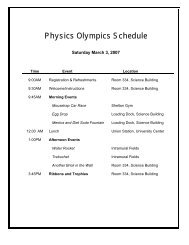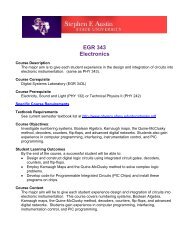Program - Physics & Astronomy - Stephen F. Austin State University
Program - Physics & Astronomy - Stephen F. Austin State University
Program - Physics & Astronomy - Stephen F. Austin State University
You also want an ePaper? Increase the reach of your titles
YUMPU automatically turns print PDFs into web optimized ePapers that Google loves.
that one-dimensional lattice gases (with interactionsperpendicular to the average step direction) cause step bunchingnear half coverage, but that the resulting change in the cyclicvoltammogram is small. The corresponding change in thecoverage itself is much too small to be observed experimentally.Here we present those results, together with preliminary work ona two-dimensional lattice gas. * M. T. M. Koper, J. J. Lubbkien,N. P. Lebedeva, J. M. Feliu, and R. A. van Santen, Surf. Sci. 478(2001) L 339-6344. † M. J. Drake, Honor’s Thesis, Texas A&M<strong>University</strong>-Commerce, 2004.AC-11 - Radio Interferometry of 1420 MHz at the <strong>Stephen</strong> F.<strong>Austin</strong> Observatory, Andrew Wagers, <strong>Stephen</strong> F. <strong>Austin</strong> <strong>State</strong><strong>University</strong>, ajwagers@yahoo.com. The theory of radiointerferometry is discussed with applications to sun andhydrogen emission observations. Observations from the SFAObservatory will be discussed along side theoretical predictions.Saturday, March 5, 2005Plenary Session9:00 am - PL-4 - Cosmology after Einstein, Wolfgang Rindler,<strong>University</strong> of Texas at Dallas, rindler@utdallas.edu. Moderncosmology, one of the great showcases of Einstein's GeneralRelativity, nevertheless stands to remind us that even a geniuscan slip. Perhaps the only one of the truly groundbreaking ideasthat Einstein had within his grasp but did not seize is theexpansion of the universe. We shall here report on wherecosmology is heading these days.Session BA10:00 am - BA-1 - Designing a Nuclear Device as a LearningExercise, The authors would like to thank the illustriousProfessor Patrick Polley, David Kahl, kahld@stu.beloit.edu,Chad Huibregtse, huibregt@stu.beloit.edu, Also presentingauthor Steve Abbott, abbotts@stu.beloit.edu, ElizabethBoatman, boatmane@stu.beloit.edu, Elon Candea,candeae@stu.beloit.edu, Sarah Johns, johnss@stu.beloit.edu,Jason Marmon, marmonj@stu.beloit.edu, Jared Nance,nancej@stu.beloit.edu, Eric Stall, stalle@stu.beloit.edu, JohnStierna, stiernaj@stu.beloit.edu, Loren Warmington,warmingt@stu.beloit.edu, Beloit College. The goal of thisproject was to examine in detail the difficulties involved indesigning and constructing a nuclear weapon. The research wasinitiated as a class project in a course on nuclear physics. Theworkload was divided into three primary sections: Acquisitionand Enrichment of Fissile Materials; Bomb <strong>Physics</strong>; and BombEffects. Using only publicly available materials, we were able tosuccessfully devise a step-by-step design for building a 20 KTuranium bomb, as well as detailing the processes for uraniumrefinement and the results of its detonation. Our work is relevantto the broader scientific community because it demonstrates thatthe major difficulty encountered in building an atomic weapon isacquiring fissile material.10:36 am - BA-3 - Modeling of Copper Indium/GalliumDiselenide Superlattices, Steven Scurlock,sps9999@sbcglobal.net, Robert Friedfeld, <strong>Stephen</strong> F. <strong>Austin</strong><strong>State</strong> <strong>University</strong>. The copper indium/gallium diselenidesuperlattice is investigated numerically for different layerlengths of this particular lattice matched crystal. The mainemphasis is on applying the Kronig-Penny model for therelevant band gap energies. By varying the sizes of the layers,the region where superlattice behavior should exist isdetermined.10:48 am - BA-4 - Alternative Approach to DimensionalScaling, Supported by DARPA, ONR, and Welch Foundation,Robert Murawski, rmurawski@physics.tamu.edu, AnatolySvidzinsky, asvid@jewel.tamu.edu, Marlan Scully,scully@tamu.edu, Texas A&M <strong>University</strong>. We will present acomparison between the D-scaling approach ofHerschbach/Witten and an alternative form. The new approach isfar less computationally expensive and introduces quantumnumbers in a natural way, thus allowing one to calculate excitedstates without going to a 1/D expansion. The two approacheswill be tested on the excited states of helium.11:00 am - BA-5 - Isoscaling Parameters for Light Projectileand Heavy Target Central HIC, Armando Barranon,bca@correo.azc.uam.mx, Dept. of Basic Sciences, UniversidadAutonoma Metropolitana - Azcapotzalco, Mexico City, JorgeLopez, jorgelopez@utep.edu, Dept. of <strong>Physics</strong>, The <strong>University</strong> ofTexas at El Paso. Several heavy ion collisions have beensimulated bombarding heavy targets with light projectiles andusing LATINO dynamical model, where a Pandharipandepotential replicates binary interaction and fragments areidentified via an Early Cluster Recognition Algorithm.Isoscaling parameters in the experimental range were obtained,confirming that Isoscaling relation holds for equilibratedcompound nuclear sources as well as nuclear systems producedby dynamical fragment formation. Authors acknowledgefinancial support from Grant 2-4570.5 of the Swiss NationalScience Foundation and access to the computational resources ofUAM-A and UTEP.11:12 am - BA-6 - Quantum Control of the Normal Modes OfBenzene with Ultrafast Laser Pulses, Supported by Robert A.Welch Foundation (Grant A-0929), Petra Sauer,psauer@physics.tamu.edu, Texas A&M <strong>University</strong>, YushengDou, yusheng.dou@nicholl.edu, Nicholls <strong>State</strong> <strong>University</strong>, BenTorralva, torr@cmspop.llnl.gov, Livermore NationalLaboratory, Roland Allen, allen@tamu,.edu, Texas A&M<strong>University</strong>. Remarkable innovations in laser technology havemade it possible to create laser pulses with ultrashort durations(below 100 femtoseconds) and ultrahigh intensities (above oneterawatt per cm 2 ). To understand the behavior of complexmolecules and materials in this new regime of physics,chemistry, biology, and materials science requires innovativetechniques which complement experiment and standard theory,and which can treat situations in which conventionalapproximations like the Born- Oppenheimer approximation, theFranck-Condon principle, and Fermi's golden rule are no longervalid. In this talk we describe a method that we are developing,semiclassical electron-radiation-ion dynamics (SERID), whichcan be used to perform simulations of the coupled dynamics ofelectrons and nuclei in an intense radiation field. We haveemployed this technique in studying the normal modes ofbenzene, and the possibility of controlling these modes by32




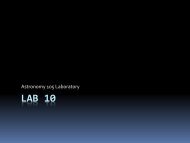
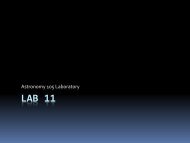
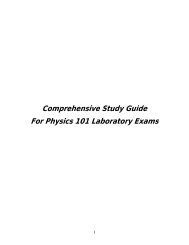

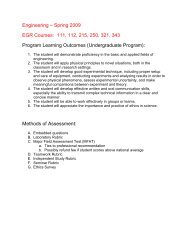
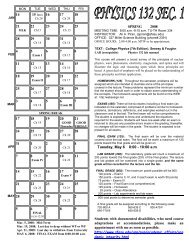
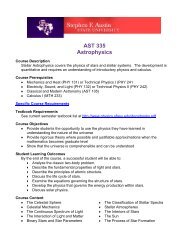

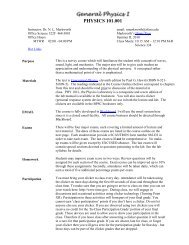
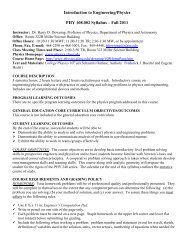
![[pdf] physics 110 fundamentals of electronics](https://img.yumpu.com/29312006/1/190x245/pdf-physics-110-fundamentals-of-electronics.jpg?quality=85)
